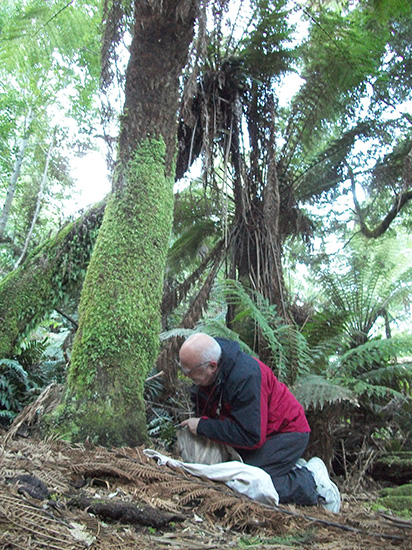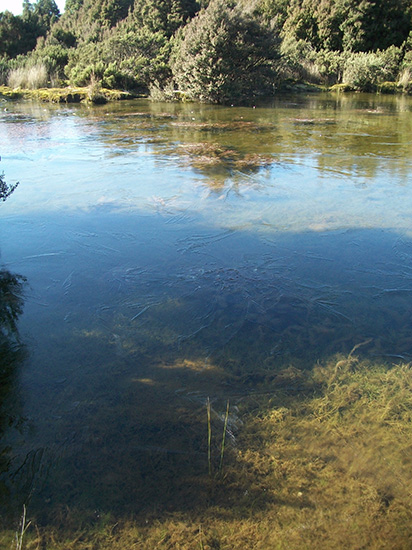From the Field: Bill Buck in Tasmania
Posted in Bill Buck, From the Field, Science on July 19 2011, by William R. Buck
Ed. note: The blogging bryologist, Mary Flagler Cary Curator of Botany, Bill Buck, is back! This time, Buck is reporting from Tasmania where he is researching mosses for a week before flying to Melbourne for the International Botanical Congress.
Thursday, July 14, 2011; Pyengana, Tasmania, Australia

Winter reared its ugly head again today. Sunrise was at about 7:00 a.m., and as soon as it became light, it was obvious that a heavy frost had whitened the landscape, including our car. So, after thawing out the car, we headed to our first site, the Weldborough Pass Rainforest Walk.
Under the canopy, the frost hadn’t covered everything, and since our primary stop that day would be at a much higher (and thus much chillier) elevation, checking out the forest, which is dominated by large southern beech (Nothofagus cunninghamii) with an understory of large tree ferns (Dicksonia), seemed like a good idea. The multitude of tree ferns at this locality was a special treat. We found a large number of bryophytes and lichens (as well as epiphytic ferns) that prefer the spongy, moist root mantles that comprise the tree fern trunks. We also found quite a large number of mosses that we had not seen before. It took a while for our fingers to thaw from the morning chill but the collecting helped keep us active and warm. In fact the collecting was so good that we ended up staying in the Weldborough Pass Rainforest an hour longer than we had scheduled. We decided to quit at a very good time, though, because as we were packing our collections into the car trunk, two other cars of tourists drove up to use the trail. We cleared out in a hurry before they could see the divots and scars we had left from our collecting!
We headed back toward the Blue Tier Nature Reserve, where we had been the day before, in order to collect in additional areas of this flora-rich reserve. Our first stop was along a small stream in a Eucalyptus forest to see a special fern, Todea barbata, which is in the same family as our royal and cinnamon ferns of the Northern Hemisphere. It is a much larger fern, however, and can grow into a small tree fern. It was a real treat to see a fern in the field that I otherwise had only known from books.
We continued up the road but stopped at the tree that had fallen over the road that I mentioned yesterday. Paddy wanted to get a photograph of it in better light, and so we used the stop as an opportunity to collect samples from the fallen canopy.

Finally we arrived at our primary destination in the Blue Tier Forest Reserve, the track up to Mt. Michael. We parked the car and noticed that the small pond across the road had frozen over. And then we were all astonished to see that the ice was 1/2” thick and that it was now 12:30 p.m. We were grateful we hadn’t spent the night up there! However, the air temperature was not unpleasant, so after eating our lunches, we headed up the track.
Right away it was obvious that this is a special place. Although the area appears natural, I read an interpretive sign indicating that tin mining had occurred here for many years, ending only in 1960. The large open areas had been settlements for the tin miners, and although there is no longer any evidence of the actual houses, the area remains mostly open and devoid of woody vegetation.
Heading up the trail, we immediately began finding mosses and lichens we hadn’t seen the day before when we were less than a mile away. The forest is quite open with little understory vegetation besides the extensive moss mats that carpet the forest floor. The vegetation shifted several times as we worked our way up the trail, often alternating between cool, shaded rain forest, and open areas with old decorticate logs scattered around. Although the entire trail was only 1.5 km (9/10 mile) one way, after over two hours I still hadn’t reached the top. Nevertheless I decided to turn back. I wanted to be able to collect along the way, rather than subjecting myself to a self-imposed forced march. Although it was only early afternoon, the winter sun seemed to come at us horizontally, right in our eyes, making it hard to see except when in the shade. Despite this impediment, we all managed to collect many interesting mosses and lichens and it was with great reluctance that we left this site as dusk descended upon us. We only saw a few small wallabies (pademelons) on the drive down, a disappointment after the really frequent sightings the night before.
This evening we drove to the little village of Pyengana–named for the Aboriginal word meaning the meeting of two rivers–for the night. This pub/restaurant/hotel is nicer than the one we stayed at last night, but like that one, the bathrooms are down a long hallway. We are the only guests staying here tonight, but there is a large number of locals enjoying the pub. I was able to get a larger room which is premitting me to spread my day’s accumulated collections out on the floor to dry. However, neither last night’s nor tonight’s accommodations had wifi (not much of a surprise when they don’t even have private bathrooms).
Tomorrow is our last field day. How time has flown! We are scheduled to visit Mt. Victoria tomorrow before returning to Hobart.
To support Bill and the Garden’s other scientists in their plant science research efforts, please donate now and help support these expeditions and studies.
Bill Buck’s Previous Reports From the Field:
July 13, 2011; Weldborough, Tasmania, Australia
July 12, 2011; Hobart, Tasmania, Australia
July 11, 2011; Hobart, Tasmania, Australia
February 8, 2011; Punta Arenas, Chile
February 5, 2011, unnamed sound northwest of Isla Georgiana
February 4, 2011, unnamed sound directly east of Seno Mama, Chile
February 2, 2011, Seno Courtenay, northern arm, Chile
February 1, 2011, Seno Courtenay, Chile
January 31, 2011, Canal between Isla Georgiana and Isla Clementina,, Chile
January 30, 2011, Unnamed sound on south side of Brecknock Peninsula, NW of Isla Georgiana, Chile
January 29, 2011, Isla Aguirre, Seno Quo Vadis, Chile
January 26, 2011, Punta Arenas, Chile
January 24, 2011, Seno Chasco, just north of isthmus to Brecknock Peninsula, Chile
January 23, 2011, Isla Grande de la Tierra del Fuego, Puerto Consuelo, Seno Chasco, Chile
January 22, 2011, Isla Grande de la Tierra del Fuego, Seno Brujo, Chile
January 21, 2011, Isla Grande de la Tierra del Fuego, Seno Brujo, Chile
January 20, 2011, Isla Grande de la Tierra del Fuego, Seno Bluff, Chile

